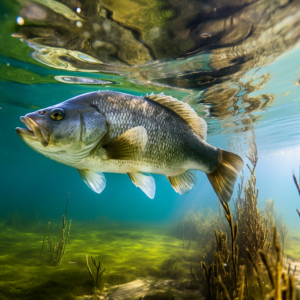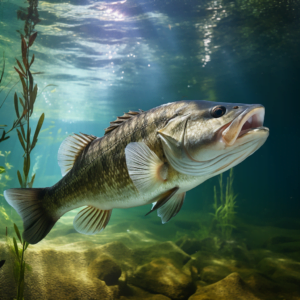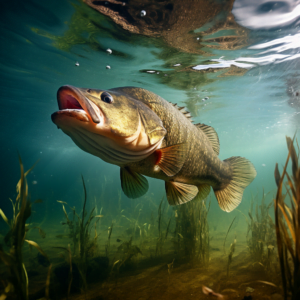Black bass is a widely recognized and popular freshwater fish that many fishing enthusiasts love to target. However, did you know that black bass actually refers to multiple species of fish? In fact, the term “black bass” is a common name used to encompass various bass species, including largemouth bass, smallmouth bass, and spotted bass. In this article, we will delve deeper into the world of black bass and explore the characteristics, habitat, and behavior of these fish. By the end, you’ll have a better understanding of what makes black bass such fascinating and sought-after catches.
Introduction
Black bass is a type of fish that is highly popular in the fishing industry. This article will provide an overview of black bass, its physical characteristics, preferred habitats, and global distribution. We will also discuss the different species of black bass, popular fishing techniques, conservation efforts, and culinary uses. By the end of this article, you will have a comprehensive understanding of black bass and its significance in the world of fishing.
Overview of Black Bass
Black bass is a common name used to refer to various species of freshwater fish belonging to the Centrarchidae family. These fish are known for their impressive fighting abilities and the challenge they provide to anglers. The most popular species of black bass include largemouth bass, smallmouth bass, and spotted bass.
Importance in the Fishing Industry
Black bass holds great importance in the fishing industry. It is one of the most sought-after game fish due to its unique characteristics and sporting qualities. Anglers all over the world are drawn to black bass because of their strength, aggression, and ability to put up a good fight. Furthermore, black bass tournaments and competitions attract a significant number of participants, showcasing the popularity and economic significance of these fish.
Identification
Physical Characteristics of Black Bass
Black bass are generally freshwater fish with elongated bodies. They have an average length of 12 to 24 inches, but some individuals can grow up to 30 inches or more. Their bodies are covered in scales, usually in various shades of green or brown. The coloration of black bass can vary depending on environmental factors such as water clarity and vegetation. They are also equipped with a prominent dorsal fin and a large mouth, which is used for capturing prey.
Distinguishing Features
While all black bass species share certain common characteristics, there are some key distinguishing features that can help differentiate them from one another. Largemouth bass, as the name suggests, have a noticeably larger mouth compared to other black bass species. Smallmouth bass, on the other hand, have a more streamlined body and are generally smaller in size. Spotted bass can be identified by a rough patch of scales on their cheeks and a series of dark spots, resembling a blotchy pattern, along their sides.
Habitat and Distribution
Preferred Habitats of Black Bass
Black bass are known for their adaptability and can be found in a wide range of freshwater habitats. They prefer slow-moving or still waters such as ponds, lakes, and reservoirs. These fish thrive in areas with abundant vegetation, submerged structure, and adequate cover, such as fallen trees or dense aquatic vegetation. Black bass are also known to inhabit rivers and streams, especially those with rocky bottoms and fast currents.
Global Distribution of Black Bass
Black bass can be found in various parts of the world, but they are particularly abundant in North America. They are native to the United States and are distributed across different states, including Florida, Texas, California, and Alabama. Outside of North America, black bass have been introduced in several countries, including Japan, Australia, and South Africa, where they have adapted well to local environments.
Popular Species of Black Bass
Largemouth Bass
Largemouth bass (Micropterus salmoides) is one of the most iconic and well-known species of black bass. It is characterized by its large mouth, which extends beyond the back of the eye. Largemouth bass are highly sought after by anglers for their aggressive nature, strong fighting ability, and their potential to grow to impressive sizes. They are often found in lakes and reservoirs and are known for hiding in structures, such as submerged logs or vegetation, to ambush their prey.
Smallmouth Bass
Smallmouth bass (Micropterus dolomieu) are smaller in size compared to largemouth bass. They have a more streamlined body and smaller mouth. Smallmouth bass are highly regarded for their acrobatic fighting style and are considered one of the toughest freshwater game fish. They are commonly found in clear, cool waters and prefer rocky or gravel bottoms. Smallmouth bass are known for their ability to thrive in rivers and streams, where they can be found near underwater ledges or rocky outcrops.
Spotted Bass
Spotted bass (Micropterus punctulatus) are a lesser-known species of black bass but are growing in popularity among anglers. They closely resemble largemouth bass, but their distinguishing features include rough scales on their cheeks and a series of dark spots along their sides. Spotted bass can be found in a variety of habitats, including rivers, reservoirs, and lakes. They are known for their aggressive feeding behavior and the challenge they present to anglers.
Fishing Techniques
Baits and Lures for Black Bass
Black bass can be caught using a variety of baits and lures. Some popular choices include plastic worms, crankbaits, spinnerbaits, and topwater lures. Plastic worms are a versatile option and can be rigged in various ways, mimicking the movement of prey. Crankbaits, which imitate injured fish, are effective for covering larger areas and attracting bass from a distance. Spinnerbaits are known for their flash and vibration, making them suitable for murky waters. Topwater lures, such as poppers or frogs, are used when bass are feeding near the surface.
Tips for Successful Black Bass Fishing
To increase your chances of success when fishing for black bass, consider the following tips:
Study the habitat: Black bass are known to hide in structures such as fallen trees, brush piles, and submerged vegetation. Locating these hiding spots can significantly improve your chances of hooking a bass.
Time your fishing: Black bass are most active during dawn and dusk, so plan your fishing trips accordingly. They are known to be less active during the warmer parts of the day or in extreme weather conditions.
Use different techniques: Experiment with different fishing techniques, such as casting, flipping, or jigging, to find what works best in a particular situation. Varying your approach can help trigger a bass’s predatory instincts.
Pay attention to the weather: Weather conditions can affect bass behavior. For example, they may be more active and willing to bite on overcast days or during periods of low barometric pressure.
Practice catch and release: As responsible anglers, it is essential to practice catch and release to ensure the long-term sustainability of black bass populations and maintain healthy ecosystems.
Conservation and Management
Efforts to Protect Black Bass Populations
Conservation efforts are crucial for maintaining healthy black bass populations and preserving their habitats. Many fishing organizations and environmental agencies work towards protecting and restoring black bass populations through initiatives such as habitat restoration, fishery management, and promoting responsible fishing practices. These efforts aim to conserve black bass populations for future generations to enjoy and ensure the sustainability of the fishery.
Regulations on Black Bass Fishing
To manage black bass populations and prevent overfishing, fishing regulations and bag limits are put into place in many regions. These regulations often include restrictions on the minimum size of bass that can be legally harvested, as well as limits on the number of bass that can be caught per day. By implementing these regulations, authorities can ensure the long-term viability of black bass populations and maintain a balance between angler enjoyment and conservation.
Culinary Uses
Black Bass as a Delicacy
Black bass is highly regarded as a delicious table fare. Its firm, white flesh has a mild flavor that is often compared to that of other popular freshwater fish, such as trout or walleye. The meat is versatile and can be prepared using various cooking methods, including grilling, baking, or pan-frying. Black bass is often appreciated for its delicate taste and the ability to complement a wide range of flavors and seasonings.
Popular Recipes Featuring Black Bass
Some popular recipes featuring black bass include:
Grilled Black Bass with Lemon and Herbs: This simple and flavorful recipe involves marinating black bass fillets in a mixture of lemon juice, herbs, and olive oil before grilling them to perfection.
Blackened Black Bass: A Cajun-inspired recipe that involves coating black bass fillets in a mixture of spices, including paprika, cayenne pepper, and thyme, before pan-searing them until blackened.
Baked Black Bass with Garlic and Butter: This classic recipe involves baking black bass fillets with a mixture of garlic, butter, lemon juice, and herbs for a delicious and savory dish.
Similar Bass Species
Striped Bass
Although striped bass (Morone saxatilis) shares the name “bass,” it is not a true black bass. Striped bass, also known as rockfish, is a popular saltwater game fish found along the Atlantic coast of North America. They can grow to impressive sizes and are known for their migratory behavior, making them a favorite target for both recreational and commercial fishermen.
Rock Bass
Rock bass (Ambloplites rupestris) are another species often confused with black bass. They are smaller and less widely distributed compared to black bass, but share some similarities in terms of physical appearance. Rock bass are often found in rocky streams and rivers and are known for their quick and aggressive strikes.
White Bass
White bass (Morone chrysops) is another popular sportfish that is sometimes mistaken for black bass. It is a freshwater fish that can be found in rivers and lakes throughout North America. White bass are known for their schooling behavior and active feeding patterns, making them a favorite among anglers seeking fast-paced action.
Frequently Asked Questions
Are Black Bass Aggressive?
Black bass, particularly largemouth bass, are known for their aggressive nature. They are opportunistic predators and will strike at a variety of prey, including small fish, crayfish, and insects. When hooked, black bass will put up a fierce fight, often jumping out of the water and making powerful runs.
What Is the Record-Sized Black Bass Caught?
The record-sized black bass has been a topic of debate among anglers, as different records exist for each black bass species and specific regions. However, the recognized world record for the largest black bass is held by George Perry, who caught a 22-pound, 4-ounce largemouth bass in Georgia’s Montgomery Lake in 1932.
Can Black Bass Be Kept as Pets?
While black bass might seem like an interesting pet due to their beauty and behavior, they are not suitable for home aquariums. Black bass are large, predatory fish that require specialized care and spacious habitats. They are better left in their natural environments where they can thrive and contribute to the aquatic ecosystem.
Conclusion
In conclusion, black bass is a diverse group of fish that includes popular species such as largemouth bass, smallmouth bass, and spotted bass. They play a significant role in the fishing industry, attracting anglers with their sporting qualities and challenging nature. The adaptability of black bass allows them to thrive in various habitats worldwide. Conservation efforts and fishing regulations are crucial for maintaining healthy black bass populations and preserving their habitats. Black bass is also highly regarded for its culinary value, and various recipes showcase its delicious taste. By understanding the different aspects of black bass, you can appreciate its significance in fishing and gain a deeper appreciation for these remarkable fish.




